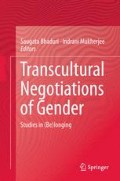Abstract
Apparently, it may seem that Hinduism is sincere towards upholding the dignity of women, as its various treatises and mythologies give us some suggestive accounts in this regard. However, behind such a projection, we can find out subtle tricks of socio-religious agencies which work for brahminical patriarchy. The non-mainstream or alternative religious practices like Tantra originated with an aim to challenge and subvert the patriarchal brahminical religious hegemony, and often provide gender equilibrium in the socio-religious space. Nevertheless, such forms were also not free from veiled patriarchal tropes and agendas. In today’s society, the baul and faqir sects of Bengal, who formed a folk-oriented sahajiya-cult incorporating tantric practices and Sufi mysticism, are internationally regarded as the believers of a de-institutionalized free society with equal religious and social rights for men and women. However, the question is to what extent do women, who serve as the ‘sadhan-sangini’ (female partner in sexo-yogic religious practices) of the bauls, actually get equal rights, dignified position and true fulfilment in religious and social life. This article tries to re-explore Indian mythological, classical as well as folk socio-religious texts, treatises and traditions to find out the hidden framework of patriarchy.
Access this chapter
Tax calculation will be finalised at checkout
Purchases are for personal use only
Notes
- 1.
Obviously it would have been thought that mentioning Shudra-s (the lower caste people whose duty was to serve the other three castes) would be unnecessary because Shudra women were easily available as they were at the lowest level in the conjugal hierarchy operated by the brahminical society. Manu’s law states after the Smritikaras: “It is declared that a Sudra woman alone [can be] the wife of a Sudra, she and one of his own caste [the wives] of a Vaisya, those two and one of his own caste [the wives] of a Kshatriya, those three and one of his own caste [the wives] of a Brahmana” (Buhler 1886, p. 88).
- 2.
Mahabharata tells us that, these two ladies had to mate with a famous old hermit, Maharshi Vedavyas, as their husband Vichitravirya died without leaving any successor to the throne. However, the Maharshi was a dreadfully ugly bearded old man. So, at the time of copulation, when she looked at him for the first time, queen Ambika closed her eyes in fear. This fear was also a punishable offence, so she gave birth to a blind son, Dhritarashtra. The other queen Ambalika kept her eyes open, but her body became pale at that time in fear, so she gave birth to a pale son, Pandu.
- 3.
In this regard, tantra played its own trick. Mahanirvanatantra says that the lower castes or the Sudras only have right to practice tantric religion, they do not have the right to practice any other kind of mainstream religions or religious rites. That is why we can see that tantra became popular among low social castes. But tantra actually supported Varnashram in all other social contexts, so it failed to initiate a significant class/caste struggle.
References
Bhattacharyya, Hansanarayan. 1977. Hinduder Devdevi, 3rd part. Kolkata: Firma KLM Pvt. Ltd.
Bhattacharyya, Narendranath. 2000. Bharatiya Dharmer Itihas. Kolkata: General Printers and Publishers.
Bhattacharyya, Sukhamay. 2006. Mahabharater Samaj. Santiniketan: Visvabharati Gaveshana Prakashan Samiti.
Buhler, G 1886. The Laws of Manu, in Sacred Books of the East, Vol. XXV, ed. F Max Muller, London: Oxford at the Clarendon Press.
Chaki, Leena. 2012. Banglar Baulani. Kolkata: Dey’s Publishing.
Datta, Akshaykumar. 1888. Bharatbarshiya Upasak Sampraday, 1st Volume. Kolkata: H.M. Mookerjea and Co.
Vidyaratna, Kaliprasanna Trans. (1893). Mahanirvan Tantram (3rd Edition). Kolkata.
Author information
Authors and Affiliations
Corresponding author
Editor information
Editors and Affiliations
Rights and permissions
Copyright information
© 2016 Springer India
About this chapter
Cite this chapter
Ghosh, R. (2016). Religion and The Position of Women in Indian Society: De-Masculinizing Mythologies and Religio-Sexual Rites. In: Bhaduri, S., Mukherjee, I. (eds) Transcultural Negotiations of Gender. Springer, New Delhi. https://doi.org/10.1007/978-81-322-2437-2_5
Download citation
DOI: https://doi.org/10.1007/978-81-322-2437-2_5
Published:
Publisher Name: Springer, New Delhi
Print ISBN: 978-81-322-2436-5
Online ISBN: 978-81-322-2437-2
eBook Packages: Social SciencesSocial Sciences (R0)

